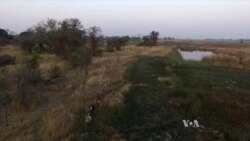An American dentist's killing of Cecil the lion, a collared 13-year-old lion monitored by the University of Oxford in Zimbabwe, sparked widespread outrage and condemnation of big-game hunting. But Trophy, a new documentary by filmmakers Shaul Schwarz and Christina Clusiau, offers a more complex perspective on trophy hunting as an industry that blurs the lines between big-game hunting and wildlife conservation.
Every year, Safari Club International holds the largest big-game hunt convention in the world in Las Vegas. Conservationist and adventurist Joe Hosmer describes the process: "You can just pick whatever animal you want from the menu that they offer, you see the price and book the kill."
Watch: Killing to Conserve? 'Trophy' Raises Difficult Questions
Prices range from $8,000 for a buffalo to $45,000 for an elephant and $350,000 for a rhino. This big-money industry helps the local communities where the hunts take place and discourages poaching, says Chris Moore, an anti-poaching campaign manager from Zimbabwe.
Moore says while poachers destroy 30,000 African elephants a year just for their tusks, trophy hunters kills 1,100 elephants annually, providing local communities with their meat and revenue. "Half of that trophy fee goes back into building a clinic or school or whatever the community decides. They have committees and a trust, which organizes where that goes."
An adventure for the rich
Filmmaker Christina Clusiau says big-game hunting caters to the rich, most of them Americans. "I couldn't believe that it was so vast that you could buy hunts, and you can buy your insurance, and you can buy your clothing and gear, everything for the safari."
Filmmaker Shaul Schwarz says he made Trophy because he wanted to understand the hunters and why they do what they do.
"The fact that you had to pay so much money is kind of more angering to some degree because you are saying, 'Oh, look at these rich white people and they are going to go and take from Africa in an almost colonial way.' You could just get angry about that and I see why, but the funny flipside is that this money hopefully will trickle down to what actually enables conservation. So," he concludes, "to some degree, if there wasn't a lot of money in the industry then it wouldn't make sense."
Trophy shows how this billion-dollar big-game industry is financing the breeding of endangered species by exploiting a small percentage of these animals for the thrill of the kill, while conserving the rest and restoring their numbers in ranches.
"That's kind of the idea of utilizing animals in this 'if it pays, it stays' way. Now, is that the answer?" Schwarz asks. "I don't know. I'm here to raise questions, but I think what we should do in this subject is be less quick to judge and scream." He knows that he is tackling a polarizing subject, and asks audiences to keep an open mind.
PETA doesn't agree
But the animal rights organization PETA does not see both sides. The group’s Associate Director of Campaigns, Ashley Byrne, condemns the big-game industry.
"Selling an endangered animal's life to raise money for conservation is like selling a child on the black market to raise money for an anti-trafficking organization. The logic is absurd! The best way to promote conservation is to protect animals' natural habitat and to invest in eco-tourism, in non-invasive forms of tourism that do make these animals commodities but alive, not dead!" she insists.
Anti-poaching activist Chris Moore agrees that in an ideal world, the wealthy would pay just as much to go and see the animals, but he adds we don't live in an ideal world, and the film shows that these hunters who want a trophy want their money's worth.
Moore suggests that if trophy hunting were banned, the animals would no longer be seen as commodities to preserve, and poaching would increase.
"When you are struggling to feed your child, you look for alternative means. I think if society maintained certain levels of prosperity, I don't think we would really see poaching."
Tough to film
The film offers a vivid cinematic experience of wildlife in Africa, but filming was tough, says Clusiau.
"When you look at these majestic creatures from afar they are majestic. They are beautiful. You want to go up and touch them and pet them and what you don’t realize is how dangerous they actually are. So, when you are in that environment, you do feel very vulnerable. So, we were lucky to have guides and trackers to kind of act as a shield to these environments."












